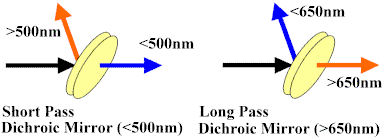

![]()
Lesson 1: Fluorescence Filters
Modern flow cytometers can simultaneously monitor fluorescent signals in three or more areas of the spectrum. This ability is due to the use of fluorescence barrier filters which permit only selected wavelengths of energy to reach the photomultiplier tube (PMT) detectors. There are three kinds of barrier filters: 1) short pass, 2) long pass and 3) band pass. These names indicate which wavelengths may pass through each kind of filter. Short and long pass filters are usually glass plates containing or coated with materials which block selected wavelengths of energy. However, band pass filters, also referred to as cavity filters, are laminates of materials that will trap all wavelengths of energy except those wavelengths which have the same dimension as the space between the laminates.
A fourth kind of filter used in flow cytometers is the dichroic mirror which is coated with materials which will reflect selected (short or long) wavelengths of energy while permitting those wavelengths not selected to pass through the mirror. These mirrors are essential in directing specific wavelengths of the spectrum to specific PMT detectors in order to make simultaneous determinations of fluorescent signals in the flow cytometer.



![]()